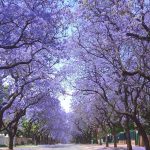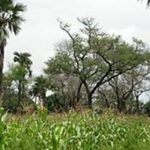TREE LIFE
December 2009
MASHONALAND CALENDAR
Sunday 13th December:
Christmas Social. Our venue this year is Bill Clarke’s property, Val D’Or, where we have held Christmas Socials before. The last time in fact was in 2006.
Our thanks go to Bill for agreeing to host us.
After tea, which will be served at 9.30 a.m., we will have a short botanical walk followed by a general knowledge quiz, which has been created by Adele.
Please bring some Christmas fare to share for tea, and bring your own lunch, a wine glass and a chair. The Society will provide some wine for those attending.
Outing to Ruzawi School
Sunday 15 November 2009
Ruzawi School lies at S18° 14.296’, E31° 32.869’, altitude 1616 m, near Marondera, 70 km east of Harare. We last visited Ruzawi School on 17 February 2006. We would like to extend our thanks to Buck and Maureen Williams, our hosts for the day, and to our leaders, Meg Coates Palgrave and Mark Hyde. Fifteen members and visitors attended the outing.
The area visited lies on the main watershed separating the Zambezi and Limpopo river systems. It is in a place of rocky granite kopjes. The soil is medium sandy loam. The Miombo Woodland is secondary and tertiary growth, mainly Julbernardia globiflora with lesser Brachystegia spiciformis and Brachystegia tamarindoides. Ground cover is sparse grass and leaf litter, with Biophytum petersianum, Vernonia glaberrima and the suffrutex Leptactina benguelensis.
Being on the watershed at +1600 m, frequent mists have resulted in good lichen and old man’s beard development. Epiphytic orchid Tridactyle tridentata was in flower, as were the terrestrial orchids Eulophia nyasae and a lone yellow flowering Eulophia penduliflora no taller than about 7 cm.
Perhaps the most interesting tree recorded was Crotalaria pallidicaulis. Forming part of the woodland understorey, the largest of several C. pallidicaulis seen, was about 2.5 m high. At this height, C. pallidicaulis is one of the smaller constituents of the woodland understorey, but is a giant in the Crotalaria genus. Most members of this genus grow to less than a meter high. The specific name of pallidicaulis refers to the pale bark. The small grey/green leaves are tri-foliolate. A number of the characteristic inflated seed pods were seen. C. pallidicaulis is a Miombo woodland special and is also, but rarely, seen in savannah woodland. It occurs in Zimbabwe, Botswana, Mozambique, Zambia, Tanzania, and the Democratic Republic of the Congo. This distribution range closely mirrors the distribution range of Miombo woodlands in sub-Saharan Africa.
Three Cussonia species were recorded, C. arborea; C. natalensis and C spicata. C. arborea has a compound palmate leaf, and tends to occur mainly on the flatter, less rocky places. It has a distinctive fruit from which it gets its common name octopus cabbage tree. C. natalensis has a simple but deeply 5-lobed leaf. Its fruit is superficially similar to the fruit of arborea, but the spikes tend to be shorter and more thickset. The leaves and fruit of spicata are distinctive, and cannot be confused with arborea and natalensis. C. spicata tends to occur on rockier or hilly places than either arborea or natalensis.
Ochna puberula is a characteristic understorey tree of granite rocky hillsides. It proved to be very variable here. Leaf length varied from about 6 cm to about 13 cm. Leaf shape varied from lanceolate to obovate to oblanceolate. Tree shape and size varied from suffrutex form, with a thick lignotuberous taproot and slender branches, to shrub size, to small tree size of about 3 m. One tree was in full bud, while most trees and shrubs bore fruit, mostly green, but some ripe and black.
From the Mashonaland tree list:
Acacia nigrescens (planted); Acacia sieberiana; Albizia amara; Albizia antunesiana; Brachystegia spiciformis; Brachystegia tamarindoides (glaucescens); Celtis africana; Combretum molle; Crotalaria pallidicaulis; Cussonia arborea; Cussonia natalensis; Cussonia spicata; Dichrostachys cinerea; Diospyros lycioides; Ekebergia benguelensis; Erythrina abyssinica; Euclea crispa; Ficus burkei (thonningii); Gymnosporia senegalensis (Maytenus); Hymenodictyon floribundum; Indigofera rhynchocarpa; Julbernardia globiflora; Lannea discolor; Ochna puberula; Ozoroa insignis (reticulata); Parinari curatellifolia; Pittosporum viridiflorum; Pleurostylia africana; Pterocarpus angolensis; Pterocarpus rotundifolius; Searsia longipes; Senna singueana; Strychnos spinosa; Uapaca kirkiana; Vangueria infausta; Vernonia amygdalina; Ziziphus mucronata.
Bernard Beekes
»»»
A challenge to Tree Society Members
Below, in italics, are some details I turned up while recently researching Crotalaria pallidicaulis. How much of the terminology in the report do you understand? Use the links below to improve your web and botanical knowledge. Use “control click” to go to the web pages when you are online.
Web page for Crotalaria palidicaulis
https://apps.kew.org/efloras/search.do
Flora of Zimbabwe glossary page
Crotalaria pallidicaulis Harms
Habitat
Miombo woodland or sometimes tree savannah, quite commonly on rock outcrops, around termite mounds or in disturbed places 750-1500 m.
Description
Shrub, 1-3(4) m tall, with hairy sometimes glabrescent branches. Leaves often with short axillary shoots bearing a cluster of smaller leaves, estipulate, 3-foliolate; leaflets 1.5-4 × 0.4-1.2 cm, very variable in shape from linear-oblanceolate to elliptic or oblong-obovate, puberulous at least beneath; petioles mostly 1.7-3.5 times as long as leaflets. Racemes with usually numerous laxly arranged flowers; bracts 2-3.5 mm long, subulate or linear-lanceolate; bracteoles small. Calyx (8)9-12 mm long, puberulous; lobes narrowly triangular, sometimes acuminate, ± as long as the tube. Standard elliptic-ovate, yellow, usually marked reddish or purple and glabrous outside; wings 0.75-0.9 times as long as the keel; keel 2-2.2(2.3) cm long, rounded about the middle with a rather short bluntly pointed beak. Pod including 0.8-1.2 cm long stipe up to 4-5.5 cm long, oblong-clavate, puberulous. Seeds c.5 mm long, oblong-reniform, granulate, ochre or brown.
Notes
In southern Zimbabwe Crotalaria pallidicaulis may be confused with C. monteiroi var. galpinii.
With acknowledgement also to Flora Zambesiaca.
Bernard Beekes
Jacaranda month – A Footnote
In her piece in last month’s Tree Life, Meg Coates-Palgrave refers to the msasa standing in Josiah Tongogara Avenue near the intersection with what used to be known as Second Street. She noted that this tree was depicted on a postage stamp in the 1990s and was called a hanging tree despite the fact that this information is probably incorrect as there is no evidence of it’s ever having been used for such a purpose.
In a conference in New Orleans last month, I sat in on a presentation by a woman who is studying the life of Nehanda. She stated that it appears to be a universal belief among Shona in Harare that Nehanda was hanged from this tree, while the historical record shows she was hanged roughly where Central Police Station is now.
But I remain curious about another of Meg’s points. If what is now Harare was truly miombo woodland before the establishment of the settlement in 1890, why does every early photograph I have ever seen seem to show only open, treeless plains?
-Ed.



